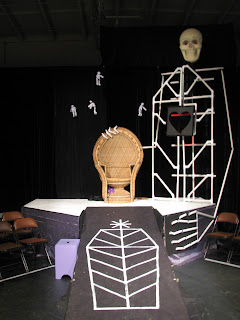by BRIAN BOZANICH, MFA
Creating Community
If you examine theatre history of the last century, you will find the names of passionate individuals who wanted to share their vision with the world. I suspect this has always been the case. The medieval tinker with a civic bent probably help nurture the York cycle into an annual tourist event. The early Kabuki dancers shared techniques and poses which helped codify the art form. These unnamed practitioners communicated their ideas and other people joined their cause. Theatre is an act of community. A single individual, whether actor, director, designer, or producer can initiate an idea, but then, they must have others join their endeavor; A single performer in a dark room emoting to no one will be acting, but not create theatre. Theatre only happens when concentric circles of community are engaged.
Creating
My current experience as artistic director, stage director, and designer for a high school program often means that the idea starts with me. There have been times when students bring me a show that excites them and we mount that production, but often the choice is mine. I choose based on creating a solid educational and audience experience. I will expand on some of my criteria for show choice in a future post, but for now, I always start from the student experience. Once I cast the show, a small community begins the process of discovery. My passion is seeing the moments of discovery on young actor's faces. When they make connections to the script, to each other, and especially when they find those connections to the people of the past who conceived the show and were there for its debut.
While this community of performers continues to discover the play, another group is crafting the physical production. Student designers generate ideas and bring those thoughts into the physical world. After thirty years in theatre, I still get the hitch in my breath when a idea of mine is made manifest, or a bit of stage composition matches a thin memory of my first encounter with the play. These two small communities must explore the ideas together for a successful production. They join forces in dress rehearsal and prepare for the last circle of community, the audience.
(A) Community
In The Search for Signs of Intelligent Life in the Universe, playwright Jane Wagner introduces Lilly Tomlin's bag lady character, Trudy, who talks to aliens. Near the end of the show, her extra terrestrial friends join Trudy in the theatre and they get goosebumps, a uniquely human experience. "They said it wasn't the play gave 'em goosebumps, it was the audience. I forgot to tell 'em to watch the play; they had been watching the audience! Yeah, to see a group of strangers sitting together in the dark, laughing and crying about the same things...that just knocked them out."
This final layer of community, the audience, closes the circle. Most theatre folks know about the growth of a show once it reaches an audience. The further discovery of meaning when you hear the feedback from the house. The meaningful silences or uncomfortable shifting in the chairs when pacing is an issue. I always run shows two weekends, even with an active school calendar, because students spend so much time and energy getting to opening night and through the first weekend of performances. If we closed then, they would not have the time to walk away, get a couple of good nights of sleep, analyze what they did, and then repeat the experiment of performance with better results. To me, this is essential learning.
Now that I have outlined my particular focus and passions, I will move on and explore the process of creating educational theatre. If you have questions, feel free to ask them in the comments.
Brian Bozanich, Visual and Performing Arts Coordinator -- Saint Joseph High School
Please visit:
Twitter: @FilmRobin for up-to-date info on where I am travelling for ART.
LinkedIn: LinkedIn.com/in/robinscottpeters for complete resume & work history.
Smashwords.com and look for Dr. Robin Scott Peters Ebooks now available.
YouTube: Youtube.com/user/robinscottpeters for all my video work.




No comments:
Post a Comment